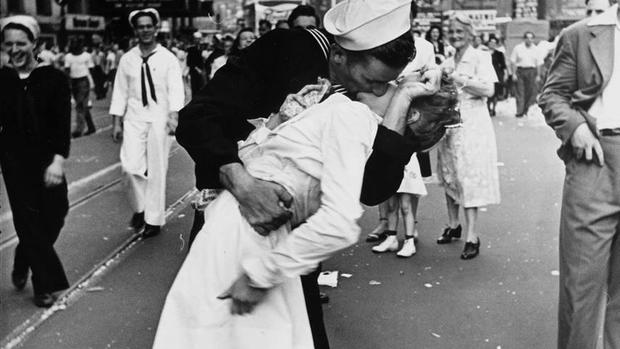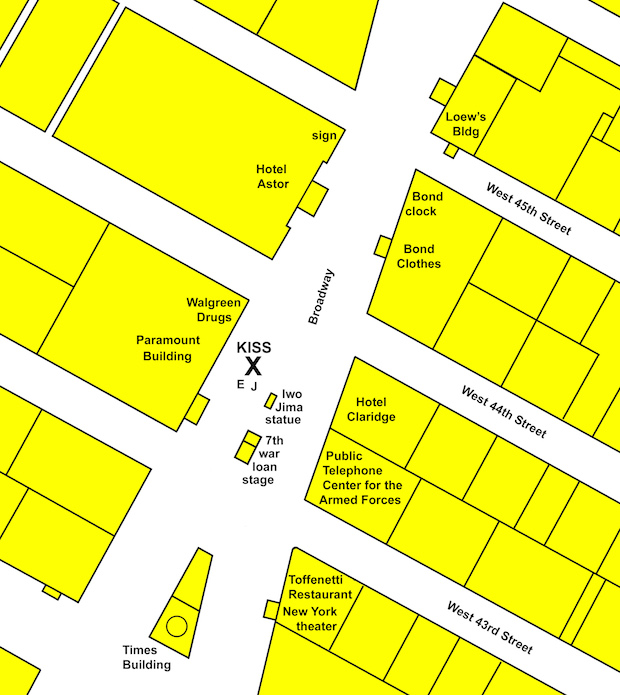Science debunks WWII "Kiss" photo couple's claim to fame
"The Kiss" is easily one of the most celebrated and contested photos in America's historical album. Taken by Life magazine photographer Alfred Eisenstaedt on Aug. 14, 1945, the iconic shot of young a sailor kissing a nurse all in white in the middle of Times Square captured the nation's collective relief and elation on the day Japan's surrender ended World War II.
But who were the sailor and the nurse? We don't know. Many people have come out over the years claiming to be the famous kissing strangers. While there are credible stories, there's no consensus. Now, to add a new wrinkle to the mystery, researchers in Texas have poked a massive hole in the leading theory.
"I can tell you some things about the picture, and I can rule some people out based on the time of day," said Texas State University astrophysicist Donald Olson. "We can show that some of the accounts are entirely inconsistent with the astronomical evidence."
Olson, along with his Texas State colleague Russell Doescher and Iowa State University astrophysicist Steven D. Kawaler, analyzed the angle of shadows in the picture and, using Manhattan's buildings as de facto sundials, calculated the precise time of day it was taken. Their results, published in Sky & Telescope, put the timestamp at 5:51 p.m. -- which makes some stories suspect at best.
Among the characters laying claim to "Kiss" fame were Edith Shain, who died at 91 in 2010 and Glenn McDuffie, who passed away last year at the age of 86. McDuffie, who was 18 in 1945, was positively identified in the photo at the age of 80 by a forensic artist. McDuffie said he remembered Shain and the magic moment.
"I was so happy. I ran out in the street," he told the Associated Press. "And then I saw that nurse. She saw me hollering and with a big smile on my face. ... I just went right to her and kissed her."
But Carl Muscarello, a former police office, also said he remembers kissing Shain that day.
The couple who gets the most credit for their story is George Mendonsa and Greta (Zimmer) Friedman.
The 2012 book "The Kissing Sailor," by Lawrence Verria and George Galdorisi, is based on Mendonsa and Friedman's story. It holds that he was coming out of a 1:05 p.m. movie at Radio City Music Hall that was interrupted only minutes into the film by rumor of the impending Japanese surrender, and that she was on a late lunch break from her job as a dental assistant. It puts the kiss at just around 2 p.m.
Olson's team said there's no way. They studied hundreds of photos and maps of Times Square in the 1940s to identify the source of a cast shadow in Eisenstaedt's picture. They determined it was from a large sign on the top of the Astor Hotel, and confirmed the theory by recreating the scene in a scale model.
Based on calculations and the simulation the kiss occurred at 5:51 p.m., nearly four hours later than the book claims.
"The widely-accepted scenario of 'The Kissing Sailor' book, with George Mendonsa kissing Greta Zimmer near 2 p.m., is ruled out by the astronomical analysis," Olson said.
"Astronomy alone can't positively identify the participants, but we can tell you the precise moment of the photograph. ... We can rule people out based on the position of the sun," he added. "The shadows were the key to unlocking some of the secrets of the iconic VJ Day images -- we know when the famous kiss happened, and that gives us some idea of who might or might not have been in the picture."



